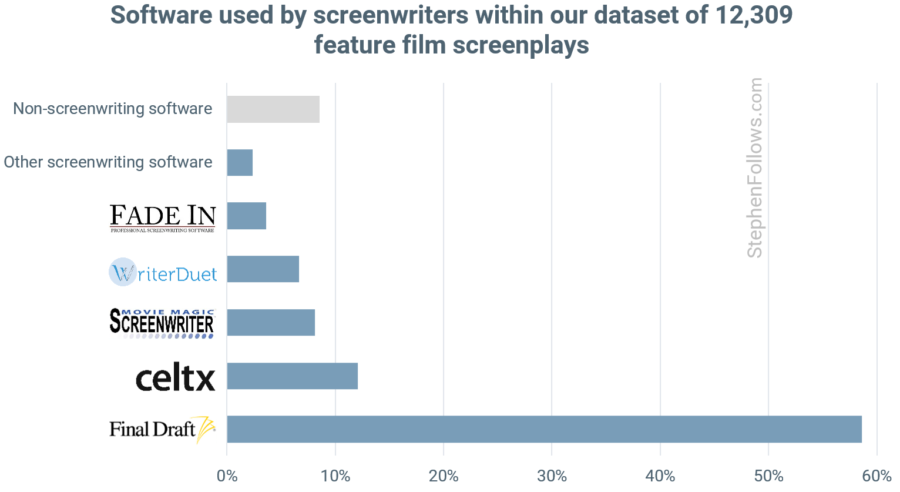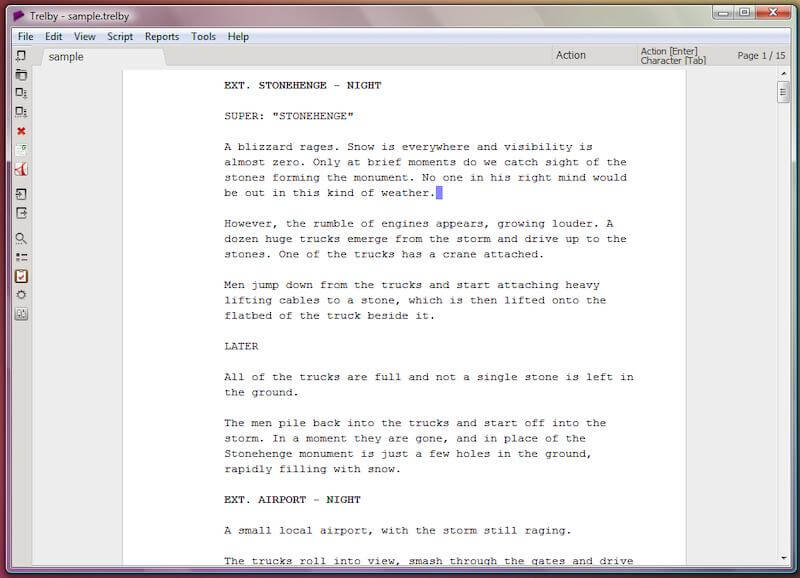Visit our website: screenplays is its own form of writing, and dedicated software makes life a whole lot easier for screenwriter. Fade In Professional Screenwriting Software is the most advanced software used by professionals writing for motion pictures, television, video games, the stage, radio, and more. It features support for multiple languages, tools for outlining, organizing, and navigating, plus extensive screenplay formatting and robust functionality for managing rewrites and revisions. WriterDuet is another web-based, free screenwriting software, which prides itself on its intuitive keystrokes to help your stories flow from your brain to your fingers, and to the.
Fade In is a screenwriting app in a world full of screenwriting apps. Where there once was only one or two big screenwriting software packages — the venerable Final Draft and Movie Magic Screenwriter — now there are several upstarts, seeking to usurp the de facto Final Draft throne.

Enter Fade In, created by General Coffee Productions. This screenwriting app rakishly steps into our limelight not as a copycat, but as a would-be kingslayer to Final Draft. Take note ye humble scribes: for a chunk less than its biggest competitor, Fade In offers a strong alternative for screenwriters of all stripes. But does it stand a chance of taking Final Draft’s place as the most popular screenwriting app on the market? Let’s dive in.
Fade In – First Impressions, Design, User Interface
We begin with the basics. Upon opening Fade In, one is greeted with a sleek design, and the name of the software fading in on the screen, because of course it does. (Why name it Fade In if you’re not going to go for a sweet splash logo?) It’s a cooler effect than it has any right to be and this feeling of pleasant surprise doesn’t stop there.
When looking at Fade In, it may sound dramatic, but it’s fair to say that this screenwriter immediately experienced a calming sensation, due to the dark gradient background that contrasts gently with Fade In’s white writing space. Mp3 to youtube downloader for mac. Of course, if calming dark gradients aren’t your bag, Fade In’s user interface can be brightened up, or the theme changed to one of three additional presets that come standard.
Fade In – Distraction Free Screenwriting
Most screenwriters can attest to the destructive power of distraction on productivity. The choice to place all the screenwriter’s essential tools and presets on the right instead of a menu bar at the top (Final Draft’s default configuration, for example) is telling, as far as where Fade In has decided to plant its flag. This panel on the right of Fade In includes the list of screenplay formatting elements (SCENE HEADING/SLUG, ACTION, CHARACTER, DIALOG, TRANSITION, etc.)

At first, I was skeptical about how Fade In places these elements and buttons, as it did seem like excessive noise within my field of vision. However, as I worked with the screenwriting UI longer, I discovered I liked having all that stuff over there. It helps because my eyes didn’t have to constantly trek upwards to see what I was doing. It was a smoother writing experience for me, and prevented me from having to constantly check what sort of element I was on (action line, dialogue line, etc.). This freed me up from having to constantly re-read what I’ve already written. For me, and many other writers, that constant glance can be deadly to inspiration, flow, and/or momentum.
Fade In’s Bag of Tricks for Screenwriters
Moving past the basics, Fade In comes with the requisite arsenal of organizing, revising, and file-formatting tools. These tools aren’t revolutionary as Fade In doesn’t try to storm the Bastille, so to speak, but the quality of the parts make for a strong sum total.
Fade In is jammed with screenwriting tools you’d expect from full-package screenwriting software like index cards, layouts, synopsis, and notes, as well full support for production (colored pages, revisions, breakdowns, reports, etc.), but it also comes with a ton of other features, such as:
Dialogue Tuner — allows you see all of a character’s dialogue in sequence, to make sure it’s consistent. Very handy. This feature is unique to Fade In, if I’m not mistaken.
Import files from a variety of file-types that includes Final Draft (.fdx or.fdr), Celtx (.celtx), Adobe Story (.astx), PDF(.pdf), and more
Export your work to PDF, Final Draft, RTF, Fountain, and various other text file types
Collaboration options for co-writing virtually
Unicode Support — for writing in languages that might not be English. Assembler for mac os.
Linux version — for screenwriters who eschew both Mac and PC.
Open Screenplay Format — an open source file format for your scripts. (Futureproofing!)
Overall, it’s a robust combination that rivals all screenwriting software on the market.
Fade In’s Intangibles
Finally, we arrive at the stuff that’s hard to put a metric to.
Unlike Final Draft, Fade In has yet to crash on me. I’ve kept it open for about a week and then, on the seventh day, I put it through its paces with opening, saving, formatting, import/export, and any other task I could think of to try to get the software to crash. It didn’t crash.
I cannot say the same for my Final Draft installation which frequently throws in the towel around page 89. Nothing disrupts a flow like losing pages of writing. While I cannot prove Fade In won’t crash eventually, I can attest that its performance so far offers more surety for my screenwriting process than anything Final Draft has to offer.
Updates are another intangible which Fade In holds the high ground in. While Final Draft’s updates are thorough, Fade In’s updates are nimble, and happen far more often. Some are essentials, others are stuff you wouldn’t miss unless you’re writing your screenplay in Japanese, but the speed and ease with which Fade In allows updates to happen gives it a slight lead over Final Draft.
Can Fade In beat Final Draft for market share?
Yes. For three key reasons:
- Price
- Streaming services
- Fade In reads, edits, and exports Final Draft files seamlessly.
Fade In is $79.
Final Draft asks $129 for their educational version and $249 for their standard version. Now, admittedly, Final Draft it may have a lot of great features, and may have come to dominate the market for screenwriting software, but as more and more potential screenwriters get used to the idea of paying $1.99 or $9.99 for apps in their mobile app store, those halcyon days of paying for expensive boxed software suites recede ever more into the distance.
If Final Draft is targeting the working screenwriter — the screenwriter who can afford $249 — that’s understandable. If I’m not mistaken, there are, at last estimate, some 10,000+ WGA members, and a good chunk of them are active and writing, with varying degree of activity and varying degree of compensation. Basing your business model solely on those writers isn’t a dumb idea. It’s actually pretty smart.
But there’s a world of new screenwriters coming up — screenwriters for whom $249 isn’t anywhere near to being a possibility. And there are thousands more of them than there are currently working writers.
Couple that with the fact that content demand has expanded exponentially due to the explosion of streaming services, and you’ve got a very volatile soup of potential customers that will likely break towards lower-end prices for screenwriting software — especially if the lower-end prices come attached to high-end quality, as does Fade In.
And then add into the mix that Fade In opens Final Draft files flawlessly, lets you edit them flawlessly, and lets you export them flawlessly so your writing partner, who’s still using Final Draft, can take your file and continue to work in Final Draft, flawlessly.
Bottom line: It may be premature to call Fade In a kingslayer just yet — Final Draft still reigns as the mainstream choice — but with its stability, ample toolset, and its fresh design, Fade In gives both amateur and professional screenwriters a solid, fully-loaded alternative screenwriting app at a much more attractive price.
Fade In Script Writing Software
At a glance
Cons
Our Verdict

Fade In is a fully featured professional screenwriting app for Mac OS X, Windows, and Linux, and is priced affordably. It has all the features you’d find in the more expensive apps, such as Final Draft and Movie Magic Screenwriter, and there’s even free and paid iPhone, iPad, and Android apps available.
As an independent filmmaker for many years who has written screenplays in AppleWorks, Word, Movie Magic Screenwriter and, for over a decade now, Final Draft. Fade In, from GCC Productions, offers many of the same features found in the pricier apps, and far more than the free and discounted ones, such as Celtx.
Like all major screenwriting software, Fade In makes it easy to just write; it handles formatting of scenes, scene headings (such as INT. HOUSE – DAY), character names, dialogue and more, using the tab and return keys. It keep track of character names and locations, so you don’t have to type them out completely—just the first couple of letters. Fade In also supports CONT’Ds and MOREs, has a pretty good spellchecker and dictionary. You can number scenes, and there is a full screen mode that keeps you focused on writing. They also provide several templates, including screenplay, stage play, television: half-hour sitcom, and television: one-hour drama.
If you’ve written a script, or read a book on screenwriting, such as Screenplay by Syd Field, you know it’s all about staying organized. Fade In offers the usual organizational tools, such as creating index cards, or a list of your scenes. What I really like is organizing by color, and not just all the scenes, but by entire sequences, or import plot points in the script. I really like this fully customizable way of organizing a script.
This is especially useful when it comes to revisions, whether you’re doing another draft to tighten the script, or on-set rewrites. In the revision mode, you can lock pages or scenes, color code the latest scene rewrites, and manage everything. You can also create various reports and breakdowns that are needed for budgeting and scheduling. Rekordbox pioneer for mac. You’ll be able to export into a format that can be easily opened by a variety of pre-production software.
Fade In Pro Free
A common and growing trend in screenwriting software is the use of different apps. Final Draft is the industry standard, but many filmmakers and writers are turning to a variety of apps, including Fade In, Celtx, Adobe Story, and more. This does have the potential to be difficult if your co-writer is using Celtx, while you write with Fade In. The only unity when opening the script files is using Final Draft’s .fdx format, or .rtf. Fortunately, Fade In can open, edit and export RTF and FDX, along with .epub, PDF, XML, and more.
In this age of cloud computing, it’s great that you can access your script online or from another computer via Dropbox. I like this, because Dropbox is proven, and I don’t have to pay a monthly or annual fee for a cloud service on top of the cost of the app.

There are two Fade In Mobile apps, for iOS (iPhone and iPad) and Android, one is free and the other is paid, but has many more features. You can import screenplays you’re working on in the desktop app via Dropbox, and work on more than one script at a time. I recommend going with the paid app.
Bottom line
Fade In Screenwriting App Download
With all the major features—and then some—found in industry standard Final Draft, but at a quarter of the price, GCC Productions’ Fade In is a great and affordable screenwriting app. It’s ability to import, edit, and export in the common .fdx format, is a huge plus. But what passes the big test for me is that the program gets out of my way and lets me be creative, while handling the chores formatting, organization, autocomplete typing, and more.
